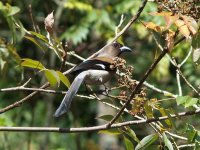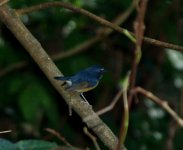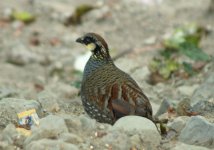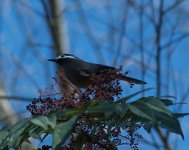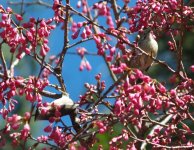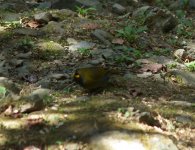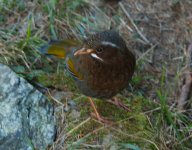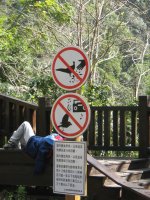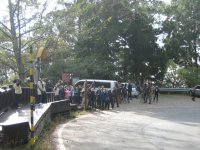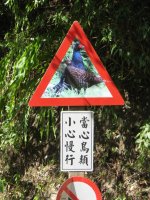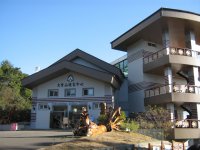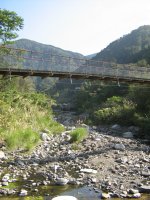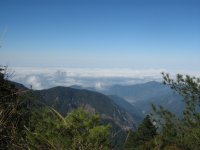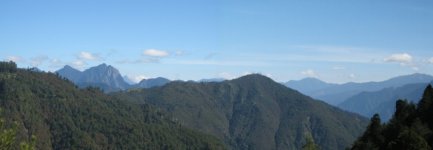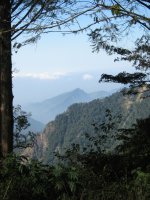Jeff Hopkins
Just another...observer

In January 2014, I was asked to take a business trip to Korea and Taiwan. I arranged to spend the intervening weekend in Taiwan in an attempt to see the remaining endemic species that I’d missed on previous visits. As Clements counts them, Taiwan has 23 endemic species and many more endemic subspecies that might become full species in the future. Knowing that the species I needed were mostly high-elevation ones, I knew that I’d need to head for the mountains. After some research, I figured that Dasyueshan (大雪山) would be the best place to visit. 21of the endemic species along with some of the endemic subspecies are possible in that area.
As an aside, other trip reports refer to visiting the “Blue Gate Trail” near Hehuanshan. I was advised that because of recent earthquakes and typhoons, the Central Cross-Island Highway is no longer open and is unlikely to be re-opened. The highway that passes by the Blue Gate Trail has by default become the only cross-island route. This has increased the amount of traffic in the area, which is leading to degradation of the habitat and less reliable bird sightings.
Dasyueshan turned out to be the right choice. I saw 15 of the 23 endemics and heard another. 5 of those endemics were lifers. However, several of the more challenging endemics are very difficult in winter since they are skulkers and aren’t singing. Those were some of the species I missed. I guess I’ll just have to finagle another trip in April. In addition to the endemics, I saw 3 more non-endemic lifers and saw or heard a total of 50 species. Considering no passage migrants were possible and we spent essentially no time in the lowlands, this is a pretty respectable total.
Additionally, I saw a handful of additional species during the business portion of the trip. These were all common lowland species in Taiwan and really wouldn’t require any birding effort to find.
Logistics:
I’d contemplated renting a car and driving myself, but with the short time allowed, I decided I’d work with a guide who had his own transport. I was eventually hooked up with Yenhui Hsu (徐彥暉 ) who I’d later learned had previously guided for several of the major international birding companies. His emaiI is [email protected]. He was a great guide and good company. He knew where the target birds were supposed to be. In fact he had guided another group to the same area the previous weekend. He also took care of booking the hotels.
Our plan was this: Yenhui would pick me up at Taipei Airport on Friday night and we’d drive from there and stay the night in Dongshih, the small city at the base of the forest road to Dasyueshan. Saturday we’d work our way up the mountain and stay at the forest reserve “hotel” near the top of the road. On Sunday we’d spend more time at the top, then work our way back down the mountain in the afternoon. He’d then drop me off at the Taichung High Speed Rail Station on Sunday night, so I could catch a train to Tainan for work the next day.
In Dongshih, we stayed at the Chang Ti Business Hotel. It’s a typical Taiwanese business hotel – clean but small rooms, though a little frayed around the edges. It cost NT$ 1860/night for room only. As it turns out, we spent all of four hours there.
The forest reserve hotel turned out to be small cabins consisting of two twin bed rooms connected by a small anteroom with chairs and a table. They had full satellite HDTV, but no heat - only an electric heating pad on the mattresses. This meant that in January at 2600m, even in Taiwan, the rooms were very cold. Each room cost NT$ 3200. The rate includes a set dinner and breakfast – Chinese food only - in the restaurant, although Yenhui arranged for a picnic box (some pastries and a juice box) for breakfast since we were heading out early. You also need to supply your own towel, but they’ll provide one for an extra NT$ 100. Frankly, it was too cold to take a shower, so that money was wasted.
Once you enter the forest reserve there aren’t any stores or restaurants until you come to the visitor center where there’s a restaurant and a small café. But we weren’t certain whether we’d make it that far up by lunchtime, so on Saturday we stopped at a 7-11 in Dongshih (they’re everywhere in Taiwan) first thing in the morning to pick up some food for our breakfast and lunch, as well as some snacks to tide us through the day. As it turned out, it was the right choice since it was late afternoon before we made it up there. We did have a late lunch at the café before heading down on Sunday.
As an aside, other trip reports refer to visiting the “Blue Gate Trail” near Hehuanshan. I was advised that because of recent earthquakes and typhoons, the Central Cross-Island Highway is no longer open and is unlikely to be re-opened. The highway that passes by the Blue Gate Trail has by default become the only cross-island route. This has increased the amount of traffic in the area, which is leading to degradation of the habitat and less reliable bird sightings.
Dasyueshan turned out to be the right choice. I saw 15 of the 23 endemics and heard another. 5 of those endemics were lifers. However, several of the more challenging endemics are very difficult in winter since they are skulkers and aren’t singing. Those were some of the species I missed. I guess I’ll just have to finagle another trip in April. In addition to the endemics, I saw 3 more non-endemic lifers and saw or heard a total of 50 species. Considering no passage migrants were possible and we spent essentially no time in the lowlands, this is a pretty respectable total.
Additionally, I saw a handful of additional species during the business portion of the trip. These were all common lowland species in Taiwan and really wouldn’t require any birding effort to find.
Logistics:
I’d contemplated renting a car and driving myself, but with the short time allowed, I decided I’d work with a guide who had his own transport. I was eventually hooked up with Yenhui Hsu (徐彥暉 ) who I’d later learned had previously guided for several of the major international birding companies. His emaiI is [email protected]. He was a great guide and good company. He knew where the target birds were supposed to be. In fact he had guided another group to the same area the previous weekend. He also took care of booking the hotels.
Our plan was this: Yenhui would pick me up at Taipei Airport on Friday night and we’d drive from there and stay the night in Dongshih, the small city at the base of the forest road to Dasyueshan. Saturday we’d work our way up the mountain and stay at the forest reserve “hotel” near the top of the road. On Sunday we’d spend more time at the top, then work our way back down the mountain in the afternoon. He’d then drop me off at the Taichung High Speed Rail Station on Sunday night, so I could catch a train to Tainan for work the next day.
In Dongshih, we stayed at the Chang Ti Business Hotel. It’s a typical Taiwanese business hotel – clean but small rooms, though a little frayed around the edges. It cost NT$ 1860/night for room only. As it turns out, we spent all of four hours there.
The forest reserve hotel turned out to be small cabins consisting of two twin bed rooms connected by a small anteroom with chairs and a table. They had full satellite HDTV, but no heat - only an electric heating pad on the mattresses. This meant that in January at 2600m, even in Taiwan, the rooms were very cold. Each room cost NT$ 3200. The rate includes a set dinner and breakfast – Chinese food only - in the restaurant, although Yenhui arranged for a picnic box (some pastries and a juice box) for breakfast since we were heading out early. You also need to supply your own towel, but they’ll provide one for an extra NT$ 100. Frankly, it was too cold to take a shower, so that money was wasted.
Once you enter the forest reserve there aren’t any stores or restaurants until you come to the visitor center where there’s a restaurant and a small café. But we weren’t certain whether we’d make it that far up by lunchtime, so on Saturday we stopped at a 7-11 in Dongshih (they’re everywhere in Taiwan) first thing in the morning to pick up some food for our breakfast and lunch, as well as some snacks to tide us through the day. As it turned out, it was the right choice since it was late afternoon before we made it up there. We did have a late lunch at the café before heading down on Sunday.






